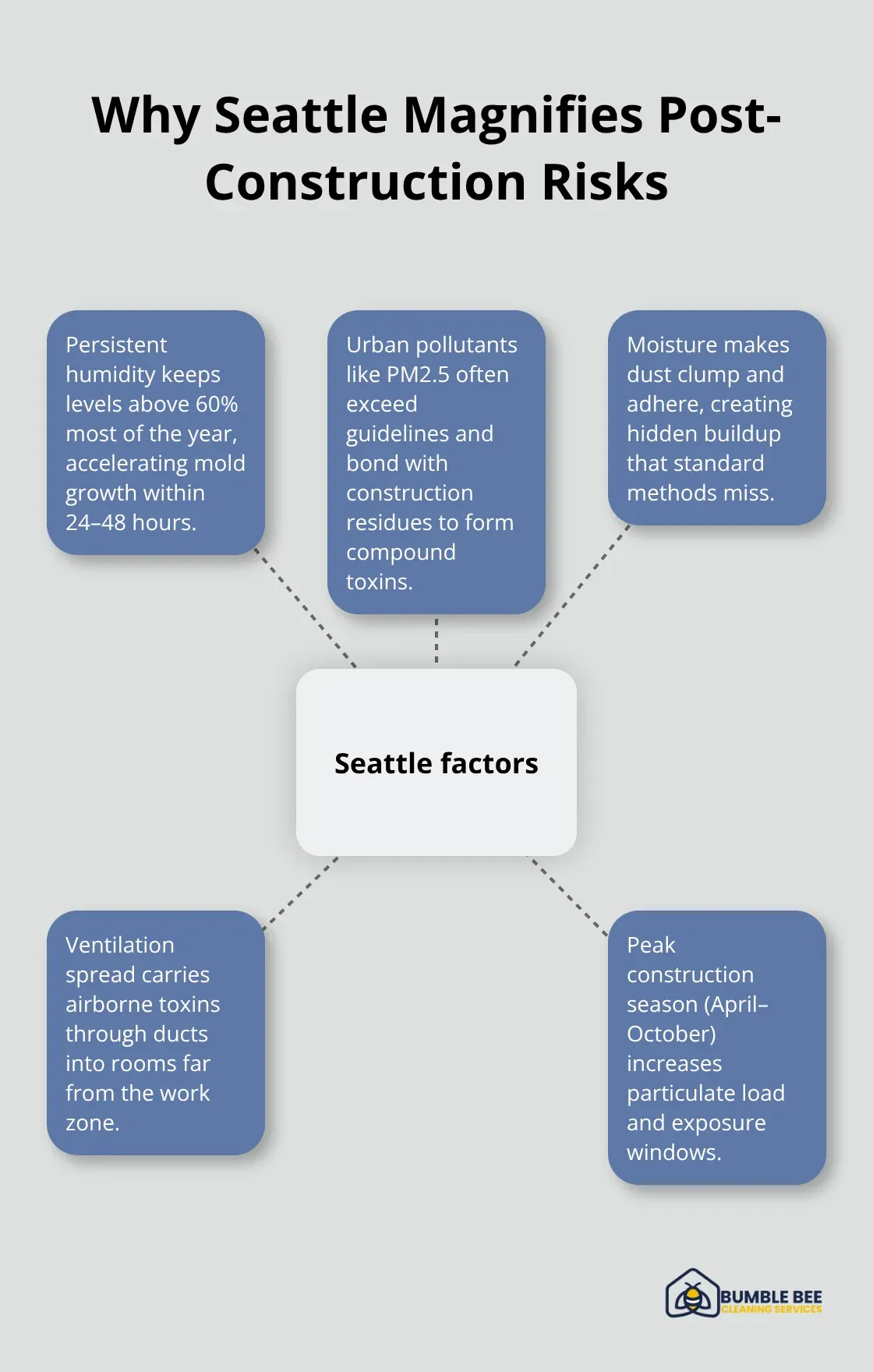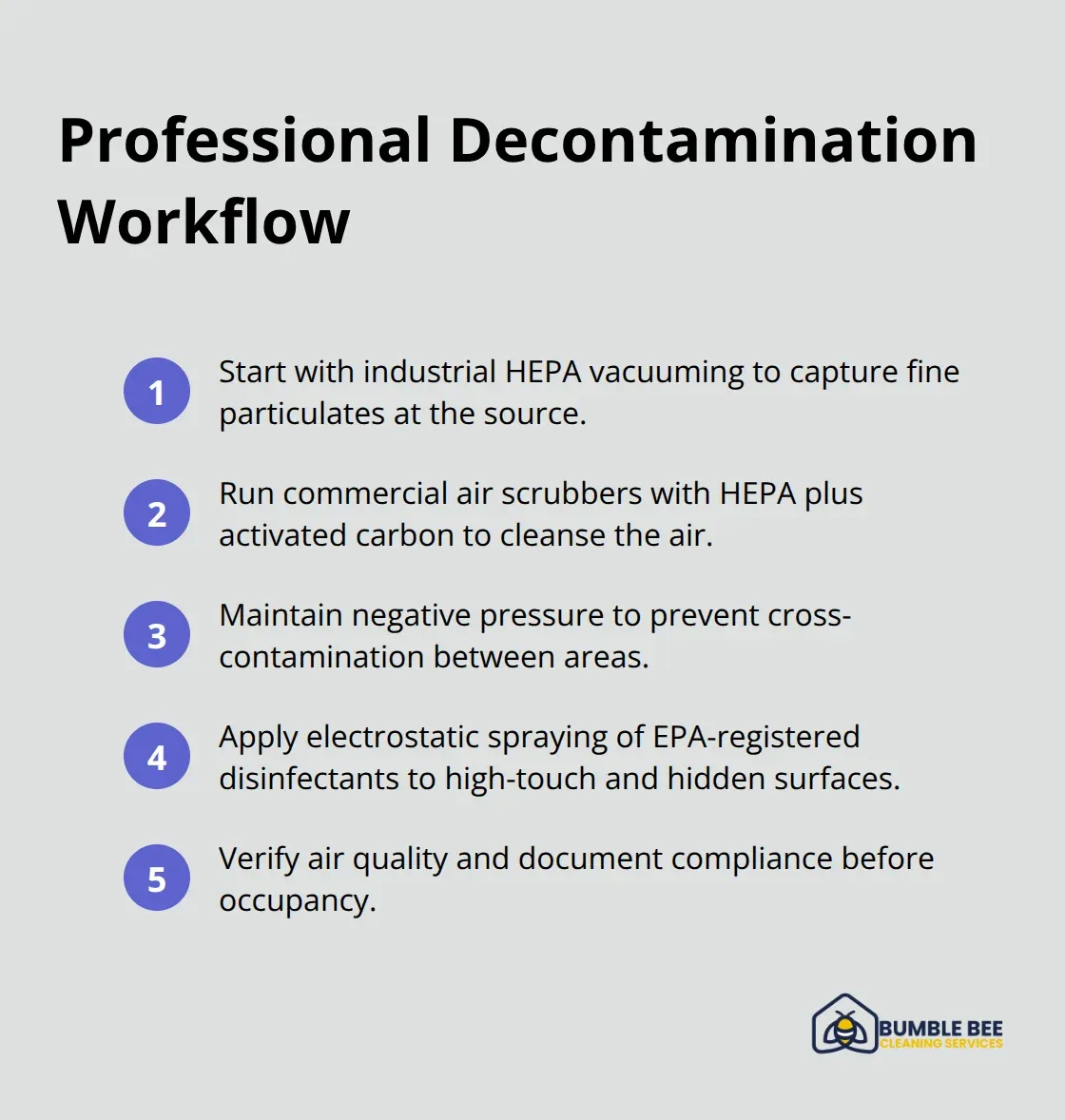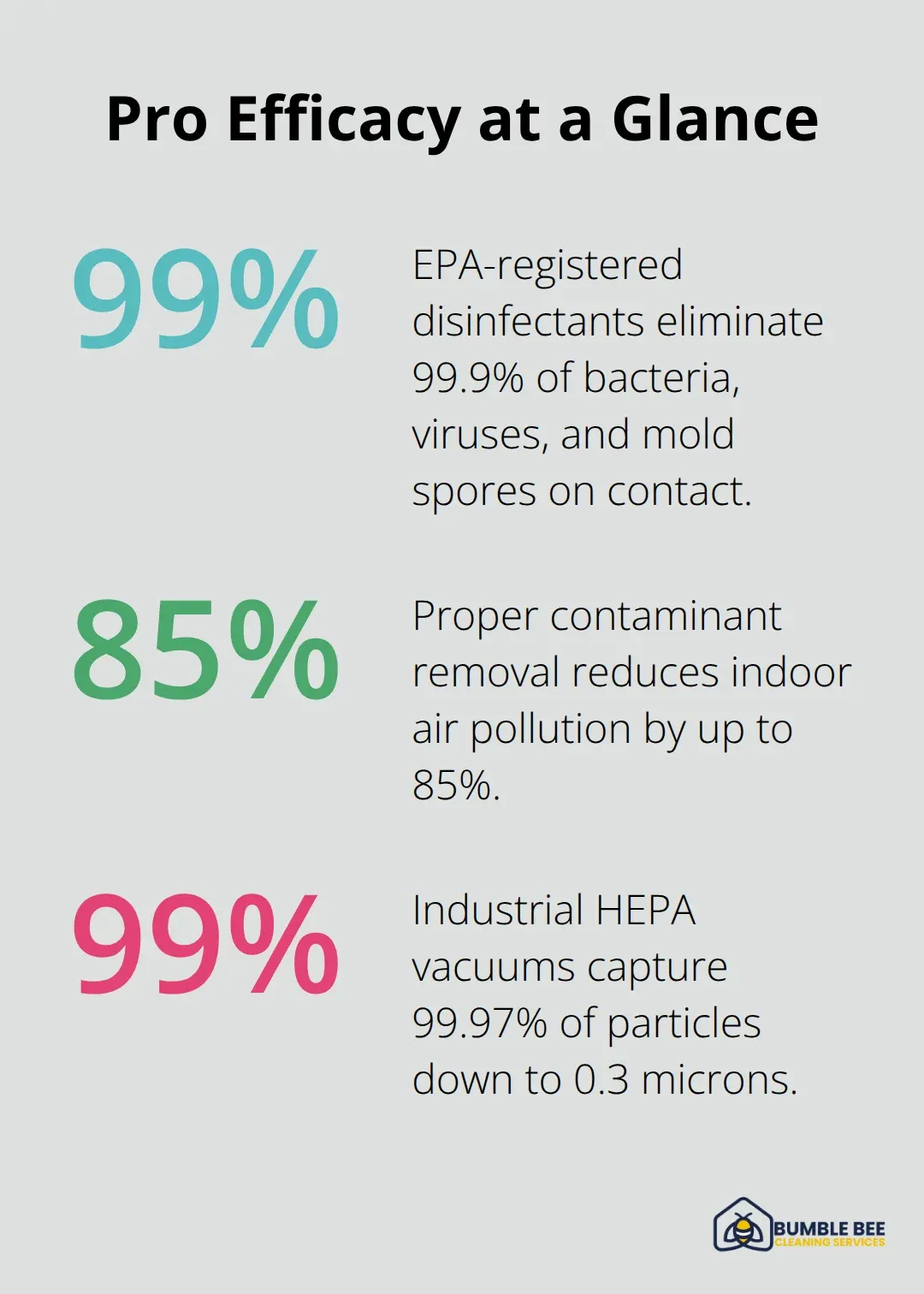Construction projects leave behind more than just dust and debris. The aftermath poses serious health risks that many property owners underestimate.
Seattle’s unique climate creates additional challenges for post-construction disinfection. We at Bumble Bee Cleaning Services see firsthand how moisture and urban pollutants compound these risks.
Professional sanitization protects your health and investment in ways DIY cleaning simply cannot match.
What Makes Construction Dust So Dangerous
Construction dust contains harmful particles that pose immediate and long-term health threats. The Occupational Safety and Health Administration identifies silica dust from concrete and bricks as a primary cause of silicosis, a potentially fatal lung disease that scars lung tissue. Asbestos exposure from older materials can lead to lung cancer and asbestosis, conditions the International Agency for Research on Cancer classifies as carcinogenic. Wood dust, plaster particles, and general construction debris create a toxic mixture that settles throughout your property long after workers leave.
Airborne Particles Attack Your Respiratory System
Fine particulate matter from construction work penetrates deep into your lungs and causes immediate irritation plus chronic health problems. Studies show that construction dust particles smaller than 10 microns bypass your body’s natural filters and lodge in lung tissue where they trigger inflammation. People with conditions like COPD face significantly higher risks, while healthy individuals can develop bronchitis and other respiratory diseases. The National Association of Home Builders reports that DIY cleanup attempts often stir up settled dust and create dangerous airborne concentrations that exceed safe exposure levels.
Chemical Residues Create Surface Contamination
Paint fumes, adhesive vapors, and chemical residues from solvents create toxic environments that standard methods cannot address. Lead dust from renovation work affects multiple organ systems (particularly neurological functions), while cement dust causes severe skin irritation and dermatitis. These contaminants settle on every surface, including HVAC systems and air ducts, where they continue to release harmful particles for months. Professional-grade HEPA filters remove 99.97% of particles larger than 0.3 microns, while standard household vacuums simply redistribute dangerous dust throughout your space.
Seattle’s unique climate conditions add another layer of complexity to these contamination challenges, particularly when moisture interacts with construction residues.
Why Seattle’s Climate Makes Post-Construction Cleaning More Complex
Seattle’s Pacific Northwest climate maintains humidity above 60% throughout most of the year, which creates moisture levels that transform construction residues into breeding grounds for mold and bacteria. This moisture causes construction dust to clump and adhere to surfaces where standard methods fail to reach them. When water combines with organic materials like wood dust and drywall particles, mold spores start growth within 24-48 hours (according to the Environmental Protection Agency). This rapid development creates airborne toxins that spread through your property’s ventilation system and contaminate areas far from the original work zone.

Urban Pollution Amplifies Construction Contamination
Seattle’s urban environment adds vehicle emissions, industrial pollutants, and particulate matter from the Puget Sound region to already dangerous construction dust. Air quality stations report that Seattle’s PM2.5 levels frequently exceed World Health Organization guidelines, particularly from April through October during construction season. These fine particles bond with construction chemicals and create compound toxins that penetrate deeper into materials. They require specialized extraction equipment for removal. Standard household air purifiers cannot handle the volume and complexity of these combined contaminants, while professional HEPA systems with activated carbon filters remove both particulate matter and chemical vapors at once.
Seattle Building Codes Require Professional Compliance
Seattle’s Department of Construction and Inspections requires post-construction documentation before they issue occupancy permits for commercial properties over 5,000 square feet. Residential projects must demonstrate proper disposal of construction waste and hazardous materials through certified contractors who follow EPA guidelines for lead and asbestos handling. Property owners who attempt DIY methods risk permit delays and fines up to $500 per violation when inspectors find inadequate dust removal or improper waste disposal. Professional services provide the required documentation and liability coverage that protects property owners from regulatory penalties while they meet Seattle’s strict environmental protection standards.
These regulatory requirements and environmental challenges demand specialized equipment and expertise that goes far beyond standard household methods.
How Professionals Remove Construction Contamination
Professional post-construction sanitization starts with industrial-grade HEPA vacuums that capture 99.97% of particles down to 0.3 microns, while standard household vacuums only filter particles larger than 10 microns and redistribute fine dust throughout your property. Commercial air scrubbers process 500-2,000 cubic feet per minute and remove airborne contaminants through multi-stage filtration systems that combine HEPA filters with activated carbon for chemical vapor removal. Negative air machines create controlled airflow that prevents cross-contamination between cleaned and uncleaned areas, while electrostatic sprayers apply EPA-registered disinfectants that eliminate 99.9% of bacteria, viruses, and mold spores on contact.

Hazardous Material Extraction Demands Specialized Training
Lead dust removal follows EPA RRP protocols that require certified technicians to contain work areas with plastic sheeting and use wet methods that prevent airborne particles. Asbestos materials demand licensed abatement professionals who wear full respirators and follow strict containment procedures, while silica dust extraction requires water suppression techniques that bind particles before removal. Professional teams test air quality with real-time monitors that measure particulate concentrations and verify safe levels before occupancy. These specialists dispose of contaminated materials through licensed hazardous waste facilities and provide documentation that satisfies Seattle’s Department of Construction and Inspections requirements for permit approval.
Complete Property Decontamination Targets Hidden Sources
Surface sanitization extends beyond visible areas to include HVAC ductwork that removes settled dust from air circulation systems, light fixture disassembly for internal access, and electrical outlet covers that trap fine particles. Professional teams clean inside cabinet frames, behind appliances, and within window tracks where construction residues accumulate and continue to release contaminants for months. Antimicrobial treatments penetrate porous materials like unsealed wood and drywall to eliminate embedded bacteria and mold spores, while ozone generators neutralize chemical odors from paints, adhesives, and solvents that standard ventilation cannot remove.
Advanced Equipment Handles Complex Contamination
Industrial moisture meters detect hidden water damage that standard methods miss (particularly important in Seattle’s humid climate), while thermal imaging cameras identify temperature variations that indicate trapped moisture or air leaks. Professional-grade dehumidifiers extract excess moisture that promotes mold growth, and UV-C sanitization systems destroy pathogens on surfaces without chemical residues. These tools work together to address contamination at the molecular level and create safe environments that meet health standards for immediate occupancy.
Final Thoughts
Professional post-construction disinfection protects your family from respiratory diseases, skin irritation, and long-term exposure to carcinogenic materials like asbestos and silica dust. The EPA reports that proper contaminant removal reduces indoor air pollution by up to 85%, while DIY methods often leave dangerous particles embedded in HVAC systems and porous surfaces. Seattle’s construction boom makes professional services even more valuable for real estate investments that command higher rental rates and sell faster in competitive markets.

DIY attempts consume over 20 hours according to the National Association of Home Builders, yet fail to address hazardous materials that require specialized equipment and training. Professional teams complete thorough sanitization in 4-6 hours with industrial HEPA systems and EPA-registered disinfectants that eliminate 99.9% of pathogens. Insurance companies recognize certified sanitization as risk reduction (often providing lower premiums for properties with proper post-construction documentation).
We at Bumble Bee Cleaning Services provide certified post-construction sanitization with eco-friendly products and quality assurance. Our experienced team uses flat-rate pricing to protect your health and investment while meeting Seattle’s strict regulatory requirements. Professional post-construction disinfection delivers health benefits that extend far beyond the initial cleanup period.
